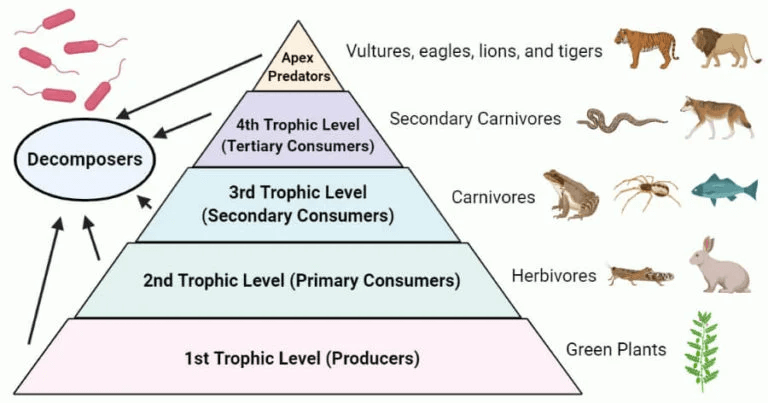Plant Parts, Nutrition, Growth Regulators and Reproduction play a crucial role in understanding how plants survive, grow, and reproduce. In the subject of Biology, studying these aspects helps us explore the structure of plant organs, the ways they obtain nutrients, the chemicals that regulate their growth, and the processes through which they reproduce, ensuring the continuation of plant life.
Previous year Questions
| Year | Question | Marks |
| 2016 | Define autotrophic nutrition. Name the type of autotrophic nutrition. | 2M |
| 2016 special | What are umbrella species ? Give an example of umbrella species. | 2M |
| 2016 special | Enlist various trophic levels in an ecosystem and give suitable example of each trophic level. | 5M |
Plant parts and their functions
Plant
- A plant is a multicellular, eukaryotic organism belonging to the kingdom Plantae.
- Plants are characterized by their ability to perform photosynthesis, a process that allows them to produce food (glucose) using sunlight, carbon dioxide, and water.
- They are autotrophs, meaning they can make their own food, and are typically fixed in one location (sessile).
Plant Parts
1. Roots
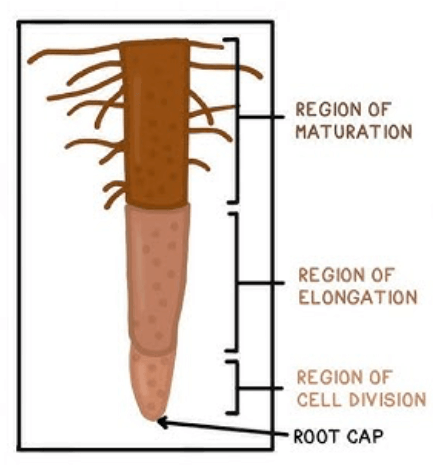
- Structure: Roots include the primary root (grows downward) and secondary roots (branch out).
- The root tip has a meristem for growth and a cap for protection.
- Types of Root Systems
- Fibrous Root: Many thin roots emerging from the base of the stem. Example: Grass, Wheat, Rice.
- Tap Root:One main thick root with smaller branching roots. Example: Carrot, Radish, Beetroot.
- Adventitious Root: Roots that grow from other parts of the plant, like stem or leaf. Example: Bamboo, Pineapple, Corn.
- Functions:
- Anchorage: Secure the plant in the soil.
- Absorption: Take in water and nutrients via root hairs.
- Storage: Store carbohydrates (e.g., starch).
- Transport: Move water and nutrients upward through the xylem.
- Reproduction: Some plants reproduce through modified roots, such as rhizomes (e.g., ginger) or tubers(e.g., potatoes).
Types of Root Modifications: Functions and Examples
| Root Modification Type | Function | Examples |
| Storage Roots | Store food and water for future use | Carrot (fusiform), Sweet potato (tuberous), Beetroot (conical) |
| Support Roots | Provide mechanical support and stability | Maize (prop roots), Banyan tree (aerial roots), Sugarcane (adventitious roots) |
| Respiratory Roots (Pneumatophores) | Facilitate gas exchange (respiration) in waterlogged environments | Mangroves (pneumatophores), Sonneratia |
| Parasitic Roots | Absorb nutrients from host plants | Cuscuta (dodder plant), Mistletoe |
2. Stem
- Structure: Stems have vascular bundles (xylem and phloem), cortex tissue, and epidermis.
- In dicots, vascular bundles form a ring; monocots have scattered bundles.
- Modified stems include runners (e.g., strawberries for vegetative reproduction), tubers (e.g., potatoes for storage), and thorns (e.g., roses for protection).
- Functions:
- Support: Hold leaves, flowers, and fruits for optimal function.
- Transport: Xylem moves water and minerals; phloem moves sugars and nutrients.
- Storage: Store food and water, especially in parenchyma cells.
- Growth: Elongate through apical meristems and thicken via lateral meristems (e.g., vascular cambium).
Types of Stem Modifications: Functions and Examples
| Stem Modification Type | Function | Examples |
| Storage Stems | Store food and water | Potato (tuber), Cabbage (bud), Onion (bulb) |
| Climbing Stems | Help plants climb for support | Pea plant (tendrils), Cucumber (tendrils), Ivy (stem tendrils) |
| Photosynthet-ic Stems | Carry out photosynthesis | Cactus (flattened stem), Opuntia (pad), Butcher’s broom (green stem) |
| Underground Stems | Store food, enable vegetative reproduction, or provide support | Ginger (rhizome), Turmeric (rhizome), Sweet potato (tuber) |
| Thorny Stems | Provide protection from herbivores | Citrus (spines), Bougainvillea (thorns) |
3. Leaves
- Structure: Leaves consist of epidermis (with stomata for gas exchange), mesophyll (where photosynthesis occurs), and veins with xylem and phloem.
- In some plants, leaves are modified for storage (e.g., succulent leaves), protection (e.g., spines in cacti), or climbing (e.g., tendrils in peas).
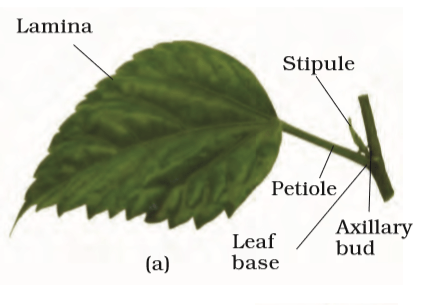
- Functions:
- Photosynthesis: Convert sunlight, water, and CO₂ into glucose and oxygen.
- Gas Exchange: Stomata allow for the exchange of gases during photosynthesis.
- Transpiration: Water loss through stomata helps pull water and nutrients from roots.
- Storage: Some leaves store water or carbohydrates, especially in succulents.
4. Flowers
- Structure: Flowers consist of four main whorls: calyx (sepals), corolla (petals), stamens (male reproductive organs), and gynoecium (female reproductive organs).
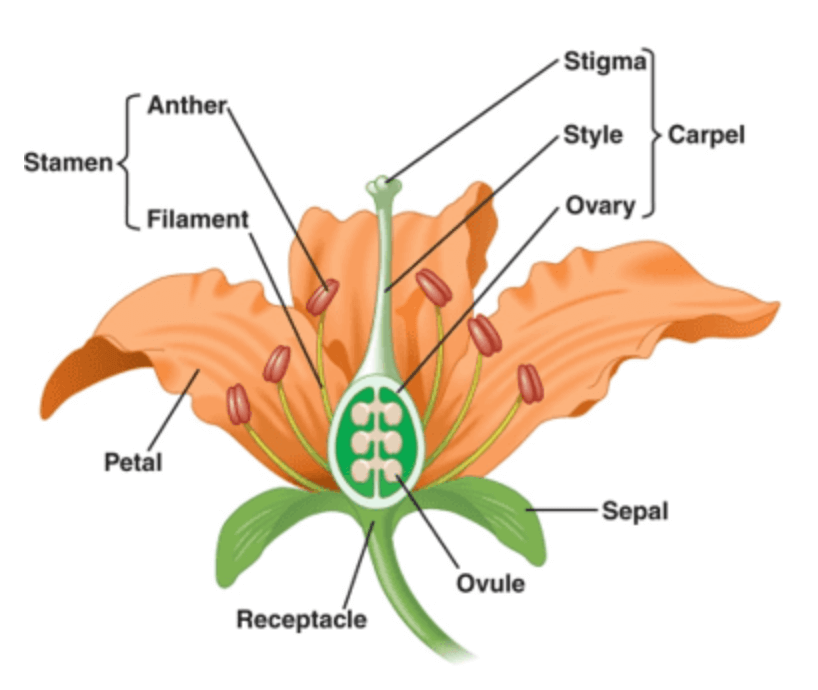
- Functions:
- Reproduction: House reproductive organs and facilitate pollination.
- Attraction: Use color, scent, and nectar to attract pollinators.
- Sexual Reproduction: Enable seed production through fertilization, ensuring genetic
- continuation of the species. Modified flowers, like unisexual flowers (e.g., in cucumbers), facilitate cross-pollination.
5. Fruits
- Structure: Fruits develop from the fertilized ovary of a flower. The fruit contains seeds surrounded by a fleshy or dry outer layer.
- The outer layer, called the pericarp, is divided into three layers:
- Exocarp: The outer skin of the fruit.
- Mesocarp: The fleshy middle part (e.g., the edible part of an apple).
- Endocarp: The inner layer, which encloses the seeds (e.g., the stone in peaches).
- Functions:
- Seed Protection: Protect the developing seeds from damage and desiccation.
- Seed Dispersal: Aid in seed dispersal through mechanisms like animal consumption (e.g., berries) or wind/water.
- Nutrient Supply: Provide sugars and nutrients to support seed development and dispersal.
6. Seeds
- Structure: A seed consists of:
- Embryo: The young plant, which includes the radicle (future root), hypocotyl (stem), and epicotyl (future leaves).
- Cotyledons: Seed leaves that store nutrients for the embryo.
- Seed Coat: Protective outer layer.
- Endosperm: Nutritive tissue (present in some seeds) that provides energy for the developing plant.
- Modified seeds include winged seeds (e.g., maples, which help with wind dispersal) and barbed seeds (e.g., burrs, which attach to animals for dispersal)
- Functions:
- Reproduction: Serve as the main reproductive unit, carrying the genetic material to develop into a new plant.
- Dormancy: Remain dormant to survive unfavorable conditions and germinate when environmental conditions are suitable.
- Dispersal: Can be dispersed by wind, water, or animals, aiding the plant in colonizing new areas.
- Nutrient Storage: Cotyledons or endosperm store energy for germination.
7. Buds
- Structure: Buds are compact, undeveloped shoots found at the tips of stems (terminal buds) or in leaf axils (lateral buds). They contain immature leaves or flowers, which are protected by scales.
- Modified buds include vegetative buds(which give rise to new shoots) and flower buds (which develop into flowers).
- Functions:
- Growth: Terminal buds contribute to the elongation of the stem, while lateral buds give rise to branches or flowers.
- Reproduction: Buds can develop into flowers or fruits, aiding in sexual reproduction.
- Protection: Buds are encased in protective scales to shield developing tissues from environmental stresses.
8. Xylem
- Structure: Xylem consists of dead, specialized cells such as tracheids and vessel elements, which form hollow tubes for water and mineral transport. It also includes xylem fibers for structural support and parenchyma for storage.
Modified xylem includes wood in trees, where xylem provides mechanical support. - Functions:
- Water Transport: Xylem transports water and dissolved minerals from the roots to the leaves via capillary action and the transpiration-cohesion-tension mechanism.
- Support: The lignin in xylem cell walls provides structural support to the plant.
- Storage: Some plants store water and nutrients in xylem for future use.
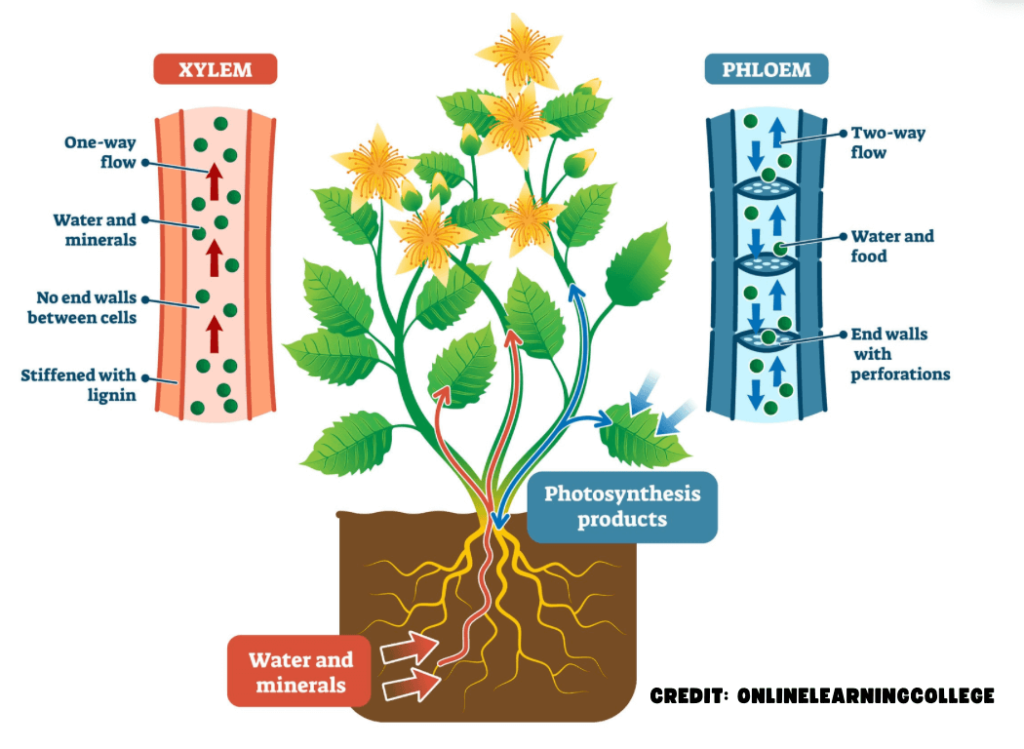
9. Phloem
- Structure: Phloem is made up of sieve tube elements, which form continuous tubes, and companion cells, which assist in loading and unloading sugars.
- Phloem also contains phloem fibers and parenchyma for storage and support.
Modified phloem may include phloem parenchyma, specialized for storage of sugars and nutrients. - Functions:
- Sugar Transport: Phloem carries sugars (mainly sucrose) from the leaves (where they are produced) to other plant parts (e.g., roots, stems, flowers) for storage or energy use.
- Nutrient Distribution: Distributes hormones, amino acids, and other organic compounds necessary for plant growth.
- Growth Regulation: Transports growth regulators like auxins, which help control plant development and responses to stimuli.
Types of Plants
- Non-Vascular Plants (Bryophytes):
- Examples: Mosses, liverworts, hornworts.
- Lacking vascular tissue (xylem and phloem), they are small, require moist environments, and rely on diffusion for water and nutrient movement.
- Vascular Plants (Tracheophytes):
- Seedless Vascular Plants: Examples include ferns and horsetails. They have vascular tissues but reproduce through spores, not seeds.
- Seed Plants: These include gymnosperms (like conifers) and angiosperms (flowering plants). Seed plants have vascular tissues and produce seeds.
- Angiosperms (Flowering Plants):
- Angiosperms are the most diverse group of plants, characterized by the presence of flowers and seeds enclosed within a fruit. Examples include trees, shrubs, and grasses.
- Angiosperms are divided into two groups:
- Monocots: One cotyledon (seed leaf), parallel-veined leaves (e.g., grasses, lilies).
- Dicots: Two cotyledons, branching-veined leaves (e.g., roses, sunflowers).
- Gymnosperms (Non-Flowering Seed Plants):
- Examples include conifers (pine, fir) and cycads.
- Gymnosperms produce seeds that are exposed, not enclosed in a fruit, and usually have needle-like leaves.
Plant Nutrition
Autotrophic Nutrition in Plant
- Plants make their own food from simple substances (like water, carbon dioxide, and minerals). They are called autotrophs. Example: Green plants, trees, grass.
Photosynthesis — How Plants Make Food
- Leaves as Food Factories: Leaves are the main site where plants make food.
- Raw Materials:
- Water and minerals: Absorbed by the roots and transported to the leaves.
- Carbon dioxide: Absorbed from the air through tiny pores on leaves called stomata.
- Chlorophyll: The green pigment in leaves that captures sunlight and helps in making food.
- Photosynthesis Process: In sunlight,chlorophyll helps convert carbon dioxide and water into carbohydrates (food), releasing oxygen as a byproduct.
- Raw Materials:
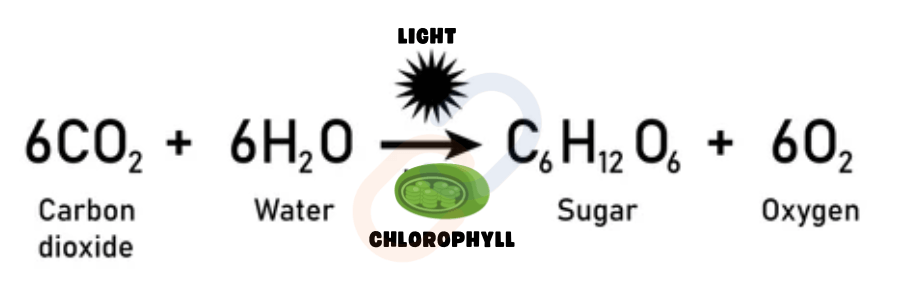
- Importance: Photosynthesis is the process that produces food and oxygen, essential for life on Earth. Without it, life would not be possible.
Stages of Photosynthesis
1. Light-dependent Reactions (Photochemical Reaction)
- Location: In the thylakoid membranes of chloroplasts.
- What happens:
- Sunlight is absorbed by chlorophyll.
- Water is split, releasing oxygen.
- ATP and NADPH (energy molecules) are produced.
2. Light-independent Reactions/Dark Chemical Reaction (Calvin Cycle)
- Location: In the stroma of chloroplasts.
- What happens:
- Carbon dioxide is used to make sugars.
- ATP and NADPH from the first stage are used to convert carbon dioxide into glucose (food for the plant).
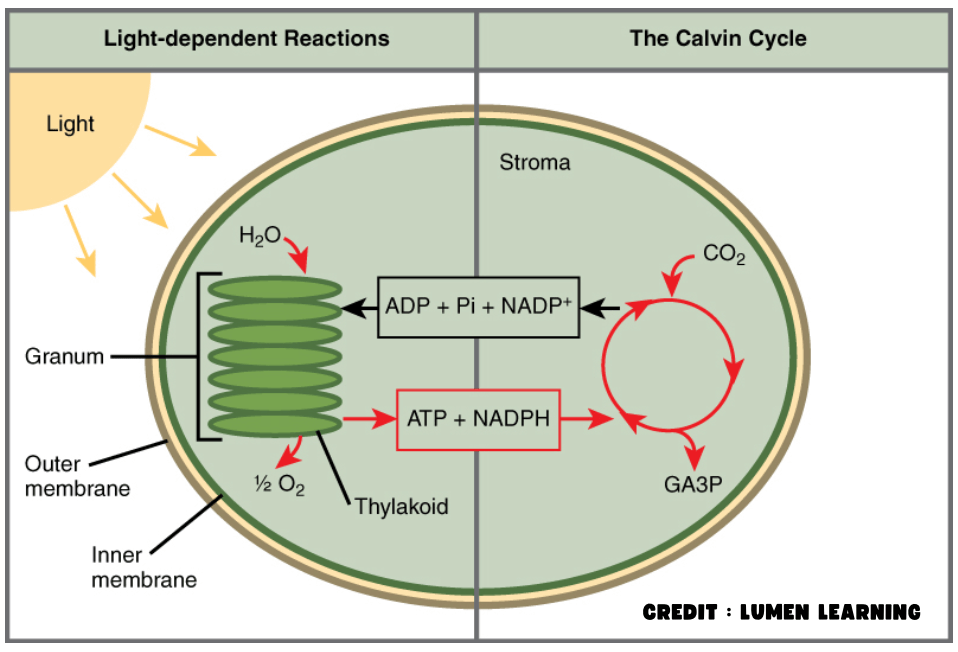
Other Plant Foods
- Carbohydrates: Plants produce carbohydrates (made from carbon, hydrogen, and oxygen) during photosynthesis.
- Proteins and Fats: Plants need nitrogen to make proteins. They get nitrogen from the soil, often with the help of special bacteria (e.g., Rhizobium) that convert air nitrogen into a usable form.
- Fertilizers: Farmers add fertilizers to provide extra nutrients like nitrogen.
- Example: Peas and beans are legumes that have Rhizobium bacteria in their roots to fix nitrogen from the air.
Heterotrophic Nutrition
- Parasitic Plants: Some plants, like Cuscuta (Amarbel), don’t have chlorophyll and can’t make their own food. They steal food from other plants (called host plants). These plants are called parasites.
- Example: Cuscuta twining around the stem of a tree; tapeworms.
- Insectivorous/Carnivorous Plants: Some plants like the pitcher plant trap insects to get extra nutrients, especially when the soil is poor in nitrogen.
- Example: Pitcher plants have a modified leaf that traps insects; Sundew, Venus Fly trap etc
- Saprotrophic Nutrition
- Fungi like mushrooms and molds get their food by breaking down dead and decaying matter. This is called saprotrophic nutrition.
- Example: Mold growing on bread or fungi on rotting wood; Ghost Plant etc
- Symbiotic Nutrition
- Lichens: Lichens are a combination of algae (which makes food) and fungi (which provides shelter and minerals). This is a symbiotic relationship.
- Leguminous plant → Rhizobium bacteria
Replenishing Nutrients in Soil
- Manure and Fertilizers: Farmers use manure and fertilizers to add nutrients like nitrogen, phosphorus, and potassium back into the soil.
- Rhizobium Bacteria: These bacteria live in the roots of legumes (like peas, beans) and help fix nitrogen from the air into the soil. In return, the plant provides food to the bacteria.
- Importance: This relationship reduces the need for extra nitrogen fertilizers in the soil.
Plant Nutrient
Macronutrients
Macronutrients are elements that plants require in large quantities for healthy growth and development. These include both primary and secondary macronutrients.
- Primary Macronutrients: Nitrogen (N), Phosphorus (P), Potassium (K)
- Secondary Macronutrients: Calcium (Ca), Magnesium (Mg), Sulfur (S)
Micronutrients (Trace Elements)
Micronutrients are needed in much smaller amounts but are equally essential for plant health. These elements are primarily involved in enzyme function, hormone production, and other metabolic processes.
- Iron (Fe), Manganese (Mn), Zinc (Zn), Copper (Cu), Boron (B), Molybdenum (Mo), Chlorine (Cl)
Nutrient Uptake and Transport
Plants absorb nutrients through the root system using both active transport (which requires energy) and passive transport (which does not require energy). The absorption of nutrients often depends on their concentration in the soil, the root’s ability to transport them, and the type of nutrient.
- Xylem: Transports water and mineral nutrients from the roots to the rest of the plant.
- Phloem: Transports sugars and other organic compounds from the leaves to the rest of the plant
| Nutrient | Function | Sources | Deficiency Symptoms |
| Macronutrients | |||
| Nitrogen (N) | Key components of amino acids, proteins, nucleic acids, and chlorophyll. Promotes vegetative growth. | Nitrate (NO₃⁻) or Ammonium (NH₄⁺) ions from soil; fertilizers like urea and ammonium nitrate. | Yellowing of older leaves(chlorosis), stunted growth, and poor fruit development. |
| Phosphorus (P) | Essential for ATP, nucleic acids, root development, flowering, and seed production. | Phosphate ions (PO₄³⁻) from soil; fertilizers like superphosphate and bone meal. | Dark green or purplish leaves, poor root growth, reduced flowering or fruiting. |
| Potassium (K) | Involved in water regulation, stomatal opening, photosynthesis, and enzyme activation. | Potassium ions (K⁺) from soil; fertilizers like potassium chloride and potassium sulfate. | Yellowing of leaf margins, necrosis, weak stems, and reduced disease resistance. |
| Calcium (Ca) | Important for cell wall structure, cell division, and growth regulation. | Calcium ions (Ca²⁺) from soil; lime or gypsum. | Poor root development, tip burn in young leaves, and distorted growth in shoots. |
| Magnesium (Mg) | Central atom in chlorophyll, involved in photosynthesis, enzyme activation, and protein synthesis. | Magnesium ions (Mg²⁺) from soil; fertilizers like magnesium sulfate or dolomitic lime. | Yellowing between leaf veins(interveinal chlorosis), stunted growth, and leaf curling. |
| Sulfur (S) | Required for the synthesis of amino acids, proteins, and vitamins. | Sulfate ions (SO₄²⁻) from soil; fertilizers like gypsum or elemental sulfur. | Yellowing of younger leaves, stunted growth, and poor fruit/seed production. |
| Micronutrients | |||
| Iron (Fe) | Essential for chlorophyll formation, electron transport, and respiration. | Ferrous (Fe²⁺) or ferric (Fe³⁺)ions from soil. | Interveinal chlorosis of younger leaves, particularly in alkaline soils. |
| Manganese (Mn) | Involved in photosynthesis (water-splitting), nitrogen metabolism, and enzyme activation. | Manganese ions (Mn²⁺) from soil. | Mottled leaf discoloration, stunted growth, and poor chlorophyll production. |
| Zinc (Zn) | Important for protein synthesis, enzyme activation, and auxin synthesis. | Zinc ions (Zn²⁺) from soil; fertilizers like zinc sulfate. | Dwarfing of plants, shortened internodes, small leaves, and reduced flowering/fruiting. |
| Copper (Cu) | Plays a role in electron transport, oxidative reactions, and lignin synthesis. | Copper ions (Cu²⁺) from soil. | Leaf wilting, dieback of growing tips, and chlorosis. |
| Boron (B) | Involved in cell wall formation, pollen germination, and carbohydrate transport. | Borate ions (B(OH)₄⁻) from soil. | Death of growing tips, poor fruit set, and distorted leaves. |
| Molybdenum (Mo) | Essential for nitrate reduction and nitrogen metabolism. | Molybdate ions (MoO₄²⁻) from soil. | Yellowing of older leaves, poor nitrogen utilization, especially in legumes. |
| Chlorine (Cl) | Involved in osmotic regulation, stomatal function, and photosynthesis (water splitting). | Chloride ions (Cl⁻) from soil. | Wilting, chlorosis, and leaf drop. |
Plant growth regulators
- Plant Growth Regulators (PGRs) are critical compounds in the control of plant growth, development, and responses to environmental stimuli.
- These substances are divided into growth promoters (which enhance growth) and growth inhibitors (which suppress or regulate certain growth processes).
Growth Promoters (Growth Factors)
These PGRs promote the growth and development of plants by influencing various physiological processes such as cell division, cell elongation, and differentiation.
1. Auxins (Growth Promoter)
Functions:
- Cell Elongation: Promotes elongation in stems and roots.
- Root Initiation: Stimulates root growth, especially in cuttings.
- Apical Dominance: Inhibits lateral bud growth, promoting vertical growth.
- Phototropism & Gravitropism: Helps the plant respond to light and gravity.
- Vascular Differentiation: Aids in the formation of xylem and phloem.
Examples:
- Indole-3-acetic acid (IAA): Natural auxin.
- Naphthaleneacetic acid (NAA): Synthetic auxin.
Uses:
- Rooting Hormones: For cuttings.
- Weed Control: Herbicides like 2,4-D.
2. Cytokinins (Growth Promoter)
Functions:
- Cell Division: Stimulates division in meristems.
- Lateral Bud Growth: Encourages branching and bushy growth.
- Leaf Senescence: Delays aging and maintains chlorophyll.
- Shoot Formation: Stimulates new shoots, especially when auxin is low.
- Chloroplast Development: Aids in chlorophyll synthesis.
Examples:
- Zeatin: Natural cytokinin.
- Benzylaminopurine (BAP): Synthetic cytokinin.
Uses:
- Tissue Culture: Promotes cell division and shoot formation.
- Cut Flowers: Delays leaf aging.
3. Gibberellins (Growth Promoter)
Functions:
- Stem Elongation: Promotes growth in plant height.
- Seed Germination: Breaks seed dormancy and stimulates enzyme activity.
- Flowering: Triggers flowering in some plants.
- Fruit Growth: Enhances fruit size, like in grapes and peaches.
- Seedless Fruit: Used to produce seedless fruits.
Examples:
- Gibberellic Acid (GA₃): Most widely used gibberellin.
Uses:
- Fruit Enlargement: Increases fruit size.
- Seed Germination: Breaks seed dormancy.
- Flowering: Promotes flowering in certain plants.
4. Brassinosteroids (Growth Promoter)
Functions:
- Cell Elongation & Division: Contributes to overall plant growth.
- Stress Resistance: Enhances tolerance to drought, cold, and salinity.
- Root Growth: Improves root development for better nutrient uptake.
- Vascular Differentiation: Improves water and nutrient transport.
Examples:
- Brassinolide: Active brassinosteroid.
- Epibrassinolide: Synthetic form.
Uses:
- Crop Yield Enhancement: Improves yields in crops like rice and wheat.
- Stress Tolerance: Enhances resistance to environmental stress.
5. Jasmonic Acid (Growth Promoter)
Functions:
- Defense Mechanism: Activates responses to herbivory and pathogen attacks.
- Flowering & Fruit Ripening: Regulates gene expression for these processes.
- Wound Healing: Aids in tissue repair after injury.
Examples:
- Jasmonic Acid (JA): Natural form.
- Methyl Jasmonate: Used in research and commercial applications.
Uses:
- Plant Defense: Improves resistance to pests and diseases.
- Secondary Metabolite Production: For pharmaceuticals and chemicals.
Growth Inhibitors
Growth inhibitors reduce or regulate excessive growth by suppressing specific growth processes like cell elongation, germination, root formation, flowering, and senescence.
1. Abscisic Acid (ABA) (Growth Inhibitor)
Functions:
- Seed Dormancy: Prevents seeds from germinating under unfavorable conditions by inhibiting enzymes needed for food mobilization.
- Stomatal Closure: Promotes stomatal closure during water stress, conserving moisture.
- Leaf Senescence: Promotes aging and leaf drop by breaking down chlorophyll.
Examples:
- Abscisic Acid (ABA): The primary inhibitor for these processes.
Uses:
- Seed Dormancy: Prevents premature seed germination for controlled farming.
- Drought Tolerance: Applied to crops to manage water stress and reduce transpiration.
2. Ethylene (Growth Inhibitor and Promoter)
Functions:
- Fruit Ripening: Accelerates ripening in climacteric fruits like bananas and tomatoes by stimulating enzymes that break down cell walls and sugars.
- Leaf Senescence & Abscission: Promotes aging and shedding of leaves, flowers, and fruits.
- Inhibition of Elongation: High concentrations of ethylene can inhibit stem elongation, especially in stressed seedlings and young plants.
Examples:
- Ethylene (C₂H₄): A gaseous plant hormone.
Uses:
- Ripening Chambers: Used to induce uniform ripening in fruits like bananas, tomatoes, and avocados.
- Flowering Control: Used to manage flowering in plants (e.g., chrysanthemums) and synchronize fruit ripening in crops.
3. Other:
- Paclobutrazol : Inhibits gibberellin biosynthesis, leading to dwarfing, reduced stem elongation, and increased branching.
- Chlormequat Chloride: Inhibits gibberellin biosynthesis, reducing stem elongation and promoting compactness in plants.
- Cytokinin Inhibitors: Inhibit cytokinin activity, suppress cell division, growth suppression. Ex- Thidiazuron, Fluridone.
Sexual and asexual reproduction in plants
Plant reproduction is the biological process through which plants generate offspring. There are two main forms of reproduction in plants.
- Sexual reproduction in plants is essential for genetic diversity, enabling plants to adapt to environmental changes. While it requires more energy and time, it provides significant advantages in the long run.
- Asexual reproduction allows for rapid reproduction and the production of genetically identical offspring, which is useful when conditions are stable. However, it lacks the genetic variation necessary for adaptation.
1. Sexual Reproduction in Plants
Sexual reproduction in plants involves the combination of male and female gametes (reproductive cells), resulting in the production of seeds. This method ensures genetic diversity and is essential for the adaptation of plants to changing environments.
Sexual Reproduction:
- Male Gamete (Pollen):
- Pollen grains are the male gametes produced by the anthers of the flower. Each pollen grain contains sperm cells (male gametes) which are necessary for fertilization.
- Female Gamete (Ovule):
- The female gamete (egg cell) is located inside the ovary of the flower. The ovule is the structure where fertilization occurs.
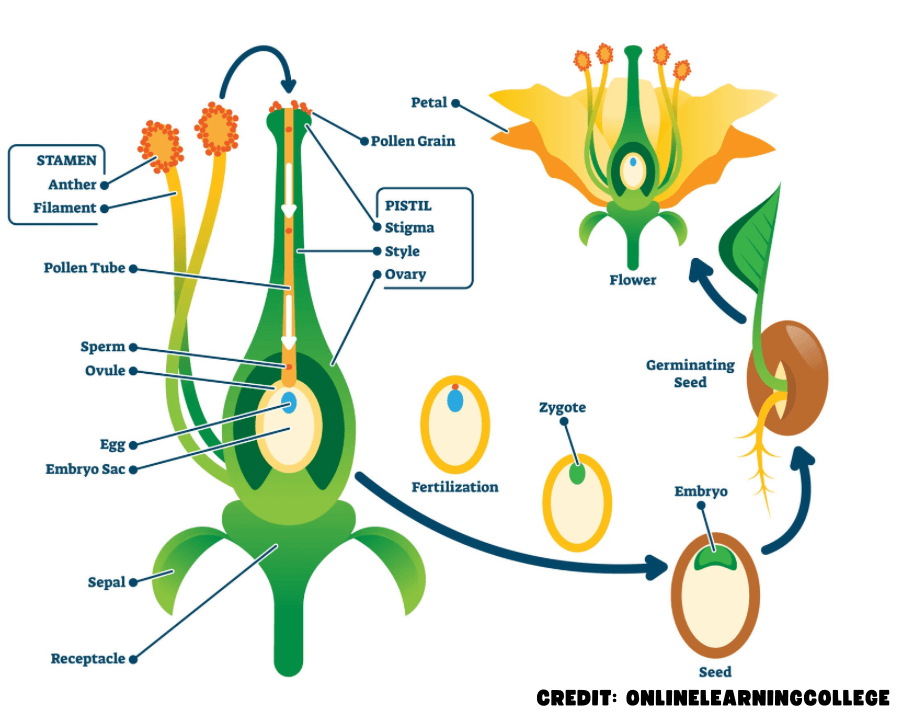
Types of Sexual Reproduction in Plants:
- Sexual reproduction in plants involves the fusion of male and female gametes (reproductive cells) to form a new organism. The process is essential for generating genetic diversity, which enhances a plant’s ability to adapt to environmental changes.
- Sexual reproduction in plants generally occurs within flowers, but the way fertilization happens can vary across species.
- There are several ways in which sexual reproduction occurs in plants, depending on how the gametes meet and the reproductive structures involved.
1. Cross-Pollination (Allogamy)
- Cross-pollination occurs when pollen from the anther (male reproductive organ) of one flower fertilizes the stigma(female reproductive organ) of a different flower, often of the same species. This ensures genetic diversity because the offspring inherit traits from two different plants.
Methods of Cross-Pollination:
- Wind Pollination (Anemophily): Wind carries pollen from one plant to another. Examples: Grasses, Conifers, Oak trees.
- Animal Pollination (Zoophily): Animals, primarily insects (e.g., bees, butterflies, beetles), birds, and sometimes bats, transfer pollen from one flower to another while searching for nectar. Examples: Bees pollinating apple trees, Hummingbirds pollinating tubular flowers.
- Water Pollination (Hydrophily): Water carries pollen from one plant to another, a rare form of pollination. Examples: Water lilies, Seagrasses.
Advantages of Cross-Pollination:
- Increased Genetic Diversity: Offspring inherit genetic material from both parent plants, leading to more variation and adaptability.
- Stronger Plants: Genetic diversity can lead to greater resistance to diseases and pests.
Disadvantages of Cross-Pollination:
- Dependence on External Factors: Pollination depends on external agents like wind, water, or animals, which may not always be available.
- Less Predictability: Since it involves two different plants, the outcome can be unpredictable.
2. Self-Pollination (Autogamy)
- In self-pollination, pollen from the anther of a flower fertilizes the stigma of the same flower or another flower on the same plant. This results in genetically similar offspring to the parent plant.
Types of Self-Pollination:
- Same Flower Self-Pollination. Examples: Pea plants, Tomatoes.
- Different Flower Self-Pollination. Examples: Zucchini, Cucumbers.
Advantages of Self-Pollination:
- Independence from External Agents.
- Stable Traits: Offspring are genetically identical or nearly identical to the parent, maintaining desirable traits.
- Efficient: It can occur even in isolated environments or when pollinators are scarce.
Disadvantages of Self-Pollination:
- Reduced Genetic Diversity: Since the offspring are genetically similar to the parent, there is less adaptability to environmental changes.
- Increased Vulnerability: If the parent plant has a genetic weakness (e.g., susceptibility to a disease), this weakness is passed on to the offspring.
3. Dioecious Pollination
- In dioecious plants, there are separate male and female plants. For fertilization to occur, pollen from the male plant must be carried to the female plant, typically via wind or pollinators. Examples: Holly, Kiwi (Actinidia), Willow
Advantages of Dioecious Pollination:
- Greater Genetic Diversity, since cross-pollination is necessary between separate plants.
Disadvantages of Dioecious Pollination:
- Need for Two Plants: At least one male and one female plant are needed for reproduction, making it difficult to propagate in some environments.
- Dependence on Pollinators.
4. Monoecious Pollination
- In monoecious plants, both male and female reproductive organs are found on the same plant but in separate flowers.
- Cross-pollination still occurs, but the same plant contains both male and female gametes, making it easier for pollination to take place within one individual plant.
- Examples: Corn, Cucumbers, Squash
Advantages of Monoecious Pollination:
- Single Plant Fertility: One plant can be pollinated by another or self-pollinated if cross-pollination is not possible.
- Reduced Need for Multiple Plants: A single plant can produce offspring, which is beneficial for agriculture.
Disadvantages of Monoecious Pollination:
- Less Genetic Diversity: If self-pollination occurs, it may lead to less genetic variation among offspring.
- Inbreeding: If cross-pollination does not occur, inbreeding may result in less robust offspring.
5. Double Fertilization
- Involves two sperm cells from a pollen grain fertilizing two cells in the ovule:
- One sperm fertilizes the egg cell, forming the zygote (plant embryo).
- The second sperm forms the endosperm, which nourishes the embryo.
Advantages:
- Efficient nutrient use with endosperm for seedling growth
- Higher seed viability and survival rates
Process of Sexual Reproduction
- Pollination
- Pollen transferred from anther (male) → stigma (female)
- Can occur via: wind, water, animals, insects
- Fertilization
- Pollen grain germinates → forms pollen tube
- Pollen tube grows through style → reaches ovary
- Male gamete (sperm) fuses with female gamete (egg) → forms zygote
- Seed Formation
- Fertilized ovule becomes a seed
- Embryo inside the seed develops into a new plant
- Ovary transforms into a fruit, protecting and dispersing the seed
- Seed Germination
- Under favorable conditions (moisture, temperature, light), seed coat breaks open
- Embryo develops into a seedling, which grows into a mature plant
Advantages of Sexual Reproduction:
- Genetic Diversity: Offspring inherit genes from both parents → genetic variation → enhances adaptability and survival.
- Adaptation to Environment: Greater genetic variation → offspring better suited to environmental challenges (e.g., drought, disease).
Disadvantages of Sexual Reproduction:
- Time-Consuming: Multiple steps (pollination, fertilization, seed formation, germination) → process takes time.
- Energy Intensive: Requires energy for flowers, pollination, and fruit production.
- Dependence on External Factors: Pollination can be hindered by lack of pollinators, poor weather, or low seed viability.
2. Asexual Reproduction in Plants
Asexual reproduction involves only one parent plant, and the offspring are genetically identical to the parent, called clones. This method does not involve the fusion of gametes and is typically faster and requires less energy than sexual reproduction.
Methods of Asexual Reproduction:
1. Vegetative Propagation:
- Vegetative propagation is a way for plants to reproduce using parts of the plant, like stems, roots, or leaves, without seeds. Main methods:
|
Natural Vegetative Propagation |
Artificial Vegetative Propagation |
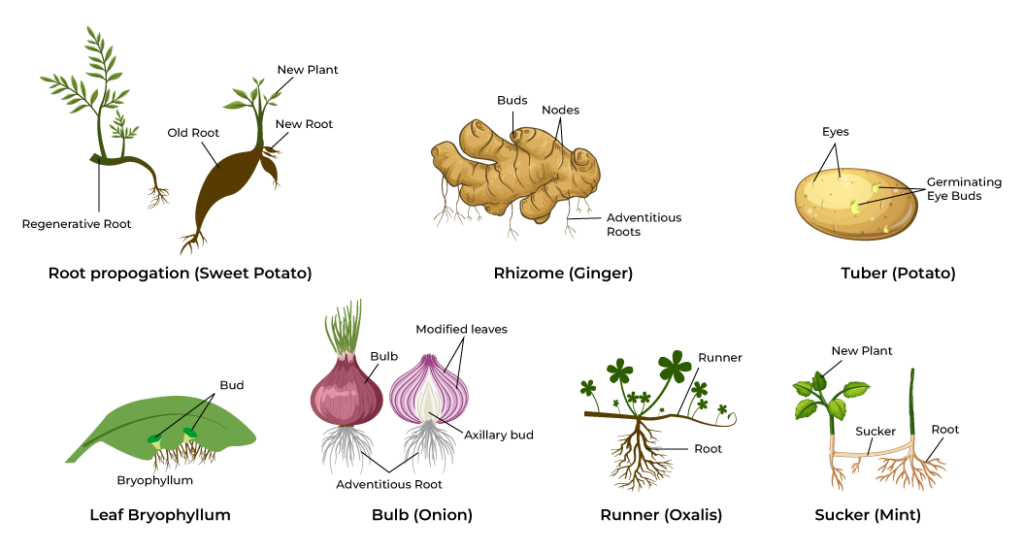 |
Steps in Tissue Culture
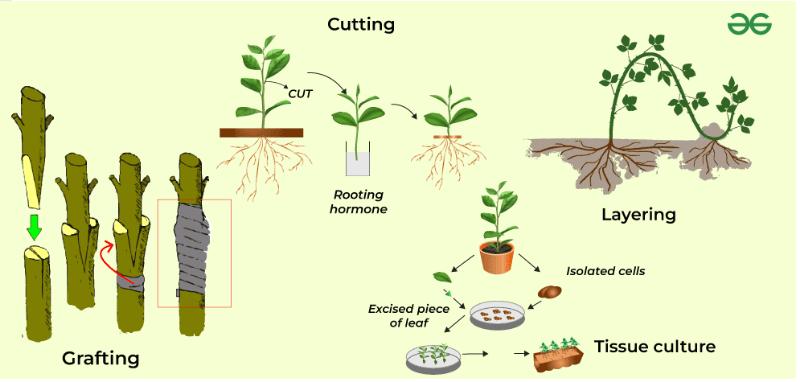 |
2. Budding
- In this process, a small outgrowth called a bud develops on the parent plant. The bud grows into a new individual and eventually detaches, forming an independent plant.
- Examples: Cacti (plants), Hydra (in non-plant organisms).
3. Spore Formation
- Spores are unicellular, reproductive structures produced by plants without the need for fertilization.
- They are lightweight, easily dispersed by wind or water, and can grow into new plants under favorable conditions. This method allows survival in harsh environments and colonization of new habitats.
- Examples: Ferns, Mosses, and some Fungi.
4. Fragmentation
- a part of the parent plant breaks off (either naturally or due to external forces) and grows into a new plant.
- Examples: Algae (e.g., Spirogyra), Aquatic plants (e.g., Water Hyacinth).
5. Apomixis
- Apomixis is an advanced method of asexual reproduction where seeds are formed without fertilization. The offspring are genetically identical to the parent plant, ensuring the preservation of desirable traits. This is especially beneficial in agriculture for producing uniform crops.
- Examples: Dandelions, Mango, Citrus plants.
Advantages of Asexual Reproduction:
- Rapid Reproduction: Asexual reproduction is quick, producing many offspring in a short period.
- No Need for Pollinators: Plants do not need pollinators or environmental factors like weather to reproduce.
- Preservation of Desirable Traits: Asexual reproduction ensures that the offspring are genetically identical to the parent, preserving useful traits such as high yield or disease resistance.
Disadvantages of Asexual Reproduction:
- Lack of Genetic Diversity: Offspring are clones of the parent plant, which limits the ability to adapt to environmental changes and increases susceptibility to diseases or pests.
- Overcrowding: As all offspring are genetically identical, they compete for the same resources, which may limit growth and development.
- Limited Adaptability: Because there is no genetic variation, the plant population may not cope well with changing environmental factors or evolving pests
Comparison of Sexual and Asexual Reproduction in Plants:
| Feature | Sexual Reproduction | Asexual Reproduction |
| Number of Parents | Two (Male and Female) | One (Parent plant) |
| Genetic Variation | High (offspring inherit traits from both parents) | Low (offspring are genetically identical) |
| Reproduction Speed | Slow (requires pollination, fertilization, and seed formation) | Fast (offspring are produced quickly) |
| Energy Requirement | High (flower production, pollination, etc.) | Low (no need for flowers or pollination) |
| Genetic Adaptability | High (promotes genetic diversity and adaptability) | Low (offspring are clones and lack adaptability) |
| Examples | Most flowering plants (e.g., apple, pea) | Potatoes, strawberries, dandelions, onions |
| Reliance on Pollinators | Yes (in animal-pollinated plants) | No (does not require pollinators) |
| Advantages | Promotes genetic diversity, which enhances disease resistance and survival. | Rapid propagation and preservation of desirable traits in offspring. |
| Disadvantages | Slower and requires more energy; may fail if pollinators or conditions are unavailable. | Lacks genetic diversity, making plants less adaptable to environmental changes. |
FAQ (Previous year questions)
Autotrophic nutrition is the process by which organisms make their own food from simple inorganic substances.
Autotrophs use energy from sunlight or chemical reactions to produce food.
Plants are the main examples of autotrophic organisms, using sunlight for photosynthesis.
Types of autotrophic nutrition: Photosynthesis: Plants, algae, and some bacteria use sunlight to synthesize food.
Chemosynthesis: Some bacteria use chemical energy from inorganic substances to make food.
A species with large area requirements for which protection of the species offers protection to other species that share the same habitat.
An umbrella species is typically a flagship species whose protection supports the survival of other species, or a keystone species chosen for conservation because of its significant influence on the ecosystem.
Umbrella species are species selected for making conservation-related decisions.
Example: The tiger is an umbrella species, as protecting its habitat also safeguards other species in the ecosystem.
Organisms occupy a specific place in the food chain based on their feeding relationship with other organisms. The position an organism holds in the food chain is called its trophic level.
Energy decreases as it moves up trophic levels (approximately 10% transfer between levels due to energy loss as heat or in metabolism).
Trophic Levels :
Primary Producers (First Trophic Level) : Autotrophic organisms (usually plants, algae, or cyanobacteria) that produce their own food through photosynthesis or chemosynthesis, using sunlight or chemical energy.
Example: Grass (produces energy via photosynthesis, forming the base of many food chains).
Primary Consumers (Second Trophic Level) : Herbivores that feed directly on primary producers to obtain energy.
Example: Grasshopper (eats grass and other plants).
Secondary Consumers (Third Trophic Level) : Carnivores or omnivores that feed on primary consumers.
Example: Frog (eats grasshoppers and other small herbivores).
Tertiary Consumers (Fourth Trophic Level) : Carnivores that feed on secondary consumers, often higher up the food chain.
Example: Snake (eats frogs and other small animals).
Decomposers/Detritivores (Not a formal trophic level but critical to ecosystems) :
Organisms that break down dead organic matter and waste, recycling nutrients back into the ecosystem. While not always listed as a trophic level, they are essential.
Example: Fungi
Plant Parts, Nutrition, Growth Regulators, and Reproduction / Plant Parts, Nutrition, Growth Regulators, and Reproduction/ Plant Parts, Nutrition, Growth Regulators, and Reproduction/ Plant Parts, Nutrition, Growth Regulators, and Reproduction/ Plant Parts, Nutrition, Growth Regulators, and Reproduction / Plant Parts, Nutrition, Growth Regulators, and Reproduction / Plant Parts, Nutrition, Growth Regulators, and Reproduction / Plant Parts, Nutrition, Growth Regulators, and Reproduction /Plant Parts, Nutrition, Growth Regulators, and Reproduction /Plant Parts, Nutrition, Growth Regulators, and Reproduction/ Plant Parts, Nutrition, Growth Regulators, and Reproduction /Plant Parts, Nutrition, Growth Regulators, and Reproduction

